The drivetrain is a critical part of any race or road car and is exposed to many forces when trying to transmit power to the wheels. It is a complex system made of of many different components, also due to the ever increasing evolution in car design, there can be different layouts, in terms of where the engine is located and what wheels transmit power.
Read on to find out about some of the components and different layouts in various designs, to help you plan your next modification or car selection and get the most fun out of your ride.
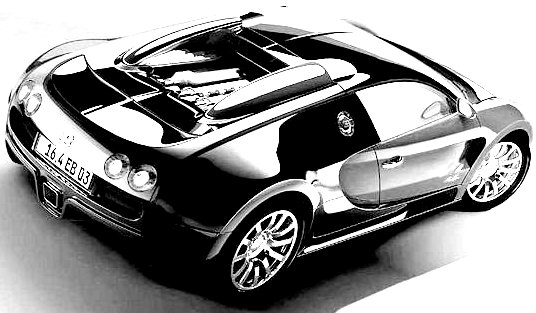
Drivetrain Layouts Comparison
Over the Year cars have transformed the way we live and travel, along with these changing times the car has had rapid evolution as well. This includes the way the power is transferred to the driven wheels and has also been to meet the different needs of various new car designs.
Different applications yield different results and below is a list of the Advantages and Disadvantages associated with them. While there is not set in stone rule for each layout, the following Drivetrain layout advantages and disadvantages tend to follow the norm.
Type of Drive | Pros/ Cons |
|---|---|
FRONT ENGINE FRONT WHEEL DRIVE (FF) 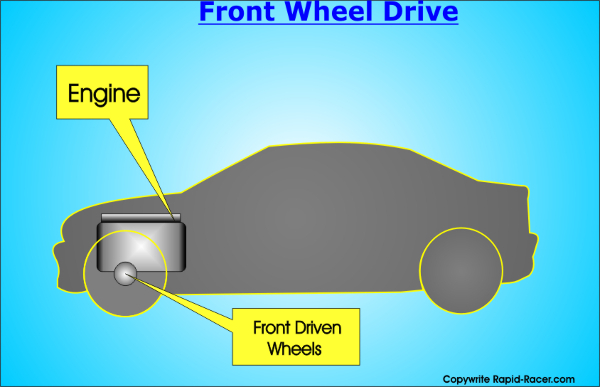 | Advantages: - Light weight. Disadvantages: - Torque Steer tendencies. - Ultimately have performance limitations for big power and handling. |
FRONT ENGINE AND REAR WHEEL DRIVE (FR) 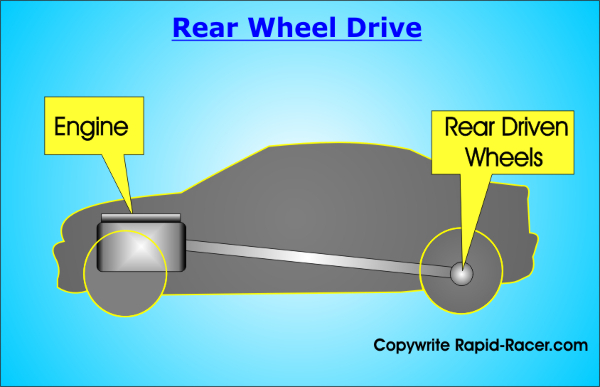 | Advantages: - 50/50 weight distribution possible. Disadvantages: - Heavier than Front-Wheel-Drive designs. |
FOUR WHEEL DRIVE (AWD) The engine can be mounted at the front , in the middle or rear of the car design. 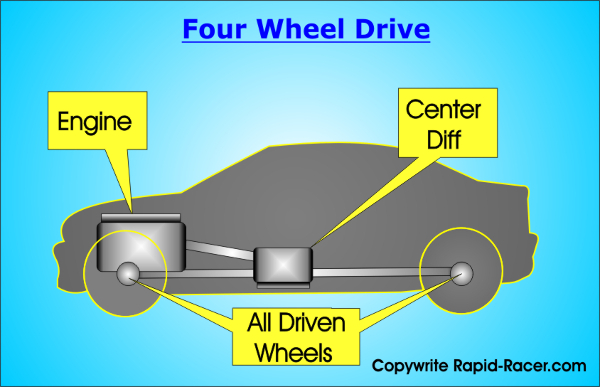 | Advantages: - Superior Traction especially in wet or slippery conditions. - Best off-road capacities. Disadvantages: - Increased weight over any other design. |
MID-ENGINE AND REAR WHEEL DRIVE (MR) 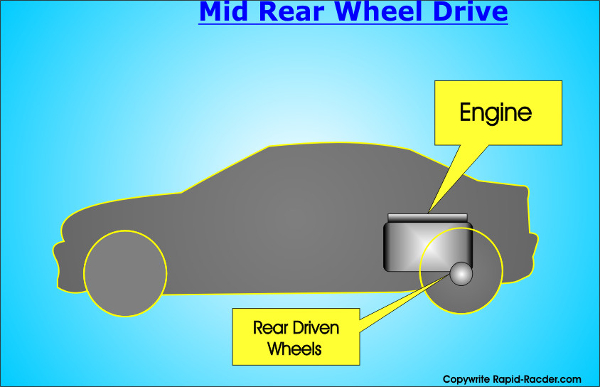 | Advantages: - Superb Handling characteristics. Disadvantages: - Hard to drive on the extreme limits. |
Front Wheel Drive (FF)
Front-wheel drive or FF as it is commonly known, is a form of engine layout used in most modern cars. It saves space and can maximise cabin space compared to other designs and is the most popular layout in modern production cars, the engine drives the front wheels and the rear wheels just roll along and aid in mostly braking and cornering force.
Most front wheel drive vehicles have a transverse engine as opposed to the the conventional longitudinal engine arrangement, generally found in rear wheel drive and four wheel drive cars. Due to all the weight being over the front of the car, FF cars are generally labelled with the understeer handling characteristics. This is ideal for road car driving requiring less skill to keep under control.
Release of the throttle while the car is under-steering, can help to cure this tendency and it also makes this a stable platform for everyday driving. Lift off oversteer can be produce by rapidly releasing and reapplying the throttle on corner entry, which can aid in the corning process and produce oversteer to aid turn in response ( depending on the overall set up).
Also due to the less mechanical parts used in construction, the overall weight and cost of the vehicle is kept to a minimum, so is a favoured design for Hot Hatches and Small Hatch Backs designs.
When engine upgrades or engineers started to increase the performance of this type of driveline, the layout tended to produce torque steer. This makes the car pull to the left or the right under heavy acceleration, which isn't an ideal situation when exiting a corner. By fitting limited slip differentials and other suspension upgrades, it is possible to help reduce these undesired tendencies.
The FF car due to it's compact engine compartment, can have issues with a restricted turning circle and increased wear of CV joints, over other designs. Unlike the benefits of a RWD car's acceleration weight transfer, the FF car can have problems getting maximum traction. This is due to the weight shifting to the rear of the car taking away some of the traction from the driven wheels, reducing grip- while accelerating.
In icy or slippery driving conditions, FF cars can again have issues getting the power down on a upward slope. But are generally considered more stable then FR cars, due to the increased weight on the front tyres/tires aiding in corning, stable and predictable handling characteristics.
Typically smaller light weight engines are used, in FF cars partly due to the better space savings and also too much weight at the front produces bad handling.
Front Engine and Rear Wheel Drive (FR)
Front engine and rear-wheel drive (FR) cars, place the engine in the front of the vehicle and the driven wheels at the rear via a driveshaft. This configuration is also known as Rear-wheel drive (RWD).
Through out history FR layout was the traditional automotive design for most of the 20th century. Rear-wheeled drive is a good balance in terms of a performance package, as a 50:50 weight ration is achievable. The front end deal with most of the braking (aided by weight transfer) and the steering, while the back is predominantly getting the power down.
This is a great balanced package, achieving a good handling car where the front deals with steering and the back looks after the power delivery. In the dry this layout can yield greater performance then FF cars due to the more equal share of the loads on tyres/wheels in terms of cornering, braking and acceleration forces. Typically you would see straight stright 6, V6, V8, V10 and V12 engine designs due to the increased room in the engine compartment and maximisation of the extra power.
Advantages under acceleration are gained due to the weight transfers of a car under power, causing the rear tyres/tires to have more traction due to the weight pushing down on them. These cars tend to have tighter turning circles due to the fact that they have less complicated drive shafts then a FF car. This type of layout is favoured in drift racing, as this is a more balanced layout and it has good oversteer handling capacities. Controllable power slides are achieved with gentle feathering of the throttle on the limit of traction (and maybe a little bit of opposite lock).
Also the layout is normally cheaper for maintenance, or easier to gain access to components then FF cars which have everything crammed in the front engine bay. Due to geometry and packaging constraints, the universal joints attached to the wheel hub have less of a tendency to wear out quicker than the CV joints found in FF cars.
The significantly shorter drive axles on a FF drive car causes the joint to flex through a much wider degree of motion. Compounded by additional stress and angles of steering, while the CV joints of a rear wheel drive car regularly see angles and wear of less than half that of front wheel drive vehicles.
The RR car is not with out it's flaws though, firstly weight for weight this layout is normally heavier then it's FF counterparts. Due to the addition of the driveshafts feeding the rear wheels, also the internal cabin space is normally reduced due to the transmission tunnel running through the middle of the cabin.
Four Wheel Drive (AWD)
In terms of performance, traction and sometimes handling; the 4WD or 4 wheel drive car has the best of both worlds compared to FF and FR layouts. Traction is nearly doubled compared to 2 wheel drive variants and this is even more evident in slippery or low grip driving conditions such as Ice or loose gravel, hence the reasons for Modern Rally cars adopting this design layout, over any other layout. Engines can be mounted at the front or the rear of the car.
The AWD system was finally perfected for rallying with the Audi quatro, as before then military vehicles had poor cornering capacity due to the front and rear wheels been locked by the differential during cornering. This meant that also when cornering the inside tyre/tire was dragged due to the smaller radius turn of the inside wheel.
Audi developed the differential to let the front and rears operate at different speeds, finally solving the handling issues normally associated with the design.
The AWD layout can be set-up to emulate FF or FR layouts with both under/oversteer characteristics. However at the limit of grip, a well balanced 4WD configuration will resist extremes of either understeer or oversteer. But it may take a more aggressive driving style to achieve a four wheel drift and get the back end out, so not suited for drifting for example.
Central differentials can be upgraded to send more torque to the rear wheels to have more of a oversteer friendly handling characteristics, but it also depends on the engine location.
It is possible to make all 4 wheels drift though, especially with modern electronic driving aids. This flexibility allows production car engineers the freedom in selecting handling characteristics that will allow a 4WD car to be driven more safely at higher speeds by inexperienced motorists than 2 wheel drive designs.
Due to the complex transmission layout and components, normally 4WD cars will result in a higher maintenance and initial costs. Also due to the extra complexity, there are larger driveline losses; so these cars can be less economical then FF or FR cars. Weight for weight, they are heavier then other design configurations.
Power normally comes in the form of a turbo charged 2.0 litres inline engines, even though the original Audi was a 5 cylinder inline engine, but there seems to be a trend of Super cars now adopting 4WD with a Mid Engine layout, creating the ultimate layout in this class.
Mid-Engine and Rear Wheel Drive (MR)
The mid-engine layout is typically chosen for its favourable weight distribution, and is consider the ultimate layout for racing cars- historically. As the heaviest component (the engine) is nearer to the centre of the vehicle, reducing the vehicle's moment of inertia and making it easier/faster to turn the vehicle to a new direction.
Also the engine weight is more evenly carried by all the wheels with this layout resulting in a more balanced handling chassis. Vehicle stability, traction, and ride quality are naturally improved when turning, braking and accelerating.
Mounting the engine in the middle of the chassis instead of the front of the vehicle, puts more weight over the rear tyres/tires also ,this results in more traction and provides increased levels of grip to the front tyres/tires in braking.
Also with less chance of rear wheel lock-up and reduced chance of a skid or spin due to the weight loads. The added weight on the rear tyres/tires can also improve acceleration on slippery surfaces. Providing much of the benefits of a AWD car without all the added weight and expense of the components, but still lacking the overall grip levels. The mid-engine layout makes ABS brakes and traction control systems work more efficiently, due to the weight loads over the Rear Tyre/ Tires.
MR cars do have more of a performance advantage (in certain weather conditions) over other designs, but less talented drivers may find them more difficult to drive at the limit, due to more precise inputs required.
Clutch
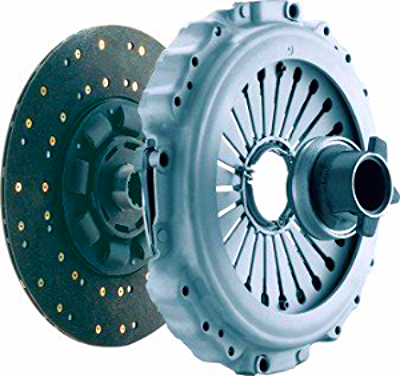
A clutch is a device for transmitting rotational forces and is part of the drivectrain, with the ability to engaged and disengaged, creating the functionality to be able to modulate power input through the driven wheels. Do not think of it as an on and off switch, as it is possible to modulate as mentioned, being able to even find the biting point and hold the car on the gasp of movement. Normally the clutch is connected via two rotating shafts. One normally the input shaft from the engine flywheel and the other the output driveshaft normally connected to a differential.
The actual "clutch" is made up of three main components. The clutch disc which is the part that is spinning around inside the gearbox/transmission and it transfers engine power to the flywheel and the rest of the drivetrain.The disc fits in between the flywheel on the back of the engine and the pressure plate. The release bearing is what moves the disc on and off the pressure plate as you operate the clutch pedal inside the vehicle with your foot. It is advisable to replace all 3 components when replacing the "clutch" assembly, this will save on further maintenance in the future.
The most basic explanation of a clutch would be of a hand held drill. One shaft is driven by the motor, and the other drives a drill chuck. The clutch connects the two shafts so that they can either be locked together and spin at the same speed (engaged), or be decoupled and spin at different speeds (disengaged).
Modifications of the clutch are needed in mild to high performance engine increases over standard equipment. This is required to help make use of the power hikes and improve drivability. Otherwise all that extra power will be lost in the drivetrain and never get to the driven wheels. There is no point in having a high performance engine, without the ability to get that power onto the road.
Flywheel
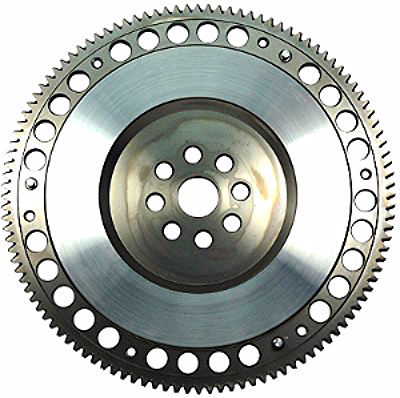
The flywheel is simple a device which is mounted on to the crankshaft, which helps to smooth out idling capacities. The flywheel is a direct connection to a car´s engine and it is part of the clutch assemble as well, as it is the clutch plate which makes contact with the flywheel. It effectively stores kinetic energy and trys to deliver a more linear torque delivery when the engine is not in its power phase of the OTTO cycle.
If a flywheel was not present, than we would get a big spike in torque, during the power phase and none present during the other stages (intake, compression and exhaust).
This is why road cars come with pretty large and heavy flywheels, to make an engine as smooth as possible, during idling at traffic lights or when in neutral.
The problem with large and heavy flywheels is that more energy is needed to be used to create inertia. This in turn reduces engine response and the ability of the engine to produce RPM´s (revolutions per minutes). If we fit a lighter flywheel, we get a more responsive engine, with less of a deficit on engine power and the and the ability to rev higher and faster.
While standard flywheels have drivability and smoothness in mind, depending on your required goals-it is possible to fit lightweight units which will help the engine in the higher Rpm's. Depending on the exact application, this could result in reduced torque or the engine dropping Revs during gear changes, so a word of caution is needed. Get it right and you can gain, harder and faster acceleration due to the reduction in the units mass inertia. Resulting in a more rev hungry responsive engine, with quicker throttle response and sharper engine pick up during engine loads.
A downside of a lighter flywheel, will be reduced smoothness at idling or when in neutral gear, also engine Rev´s will drop more quickly, when off the throttle.
Gearbox/Transmission
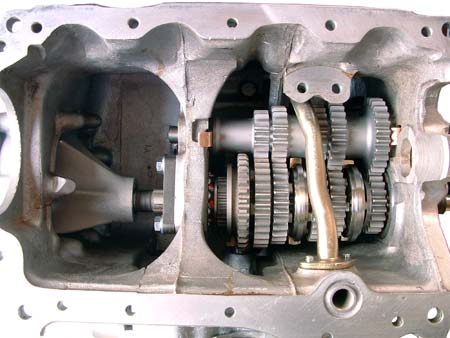
If all cars operated in a very narrow speed range, then it would be easier to choose an overall gear ratio and the gearbox/ transmission would not be required. This is not the case and due to the different terrains and landscapes, the engine and drivechain needs to meet these ever changing environments.
It can be difficult choosing the right ratio and it is always a trade off between top speed and acceleration.The higher the ratio the quicker the car will accelerate, but top speed will be sacrificed. Lower ratios produce better top speed and fuel economy. So careful consideration needs to be taken to get the desired set up and it's application.
A good example of this is trying to pull away from a standstill in 5th gear, in a low powered vehicle.The engine will most likely try to stall and the throttle will be unresponsive, let alone the strain on the drivechain. Due to the fact that both in everyday driving and on the racetrack we will come across a combination of both slow and fast corners. It becomes necessary to have a system to keep the engine in the optimum rev range.
A gear box is required to keep the Engine in this powerband at different given speed. Maximising the engines RPM and engine power to keep acceleration at it's optimum and having enough available Torque to propel the vehicle forward.
The Engine needs be operating in the optimum RPM (Revolutions Per Minute) range to get the best horsepower also. Different engines develop maximum Power at different Revs, depending on the overall goal and use of the engine
Outside the powerband and the engine falls out of the desired rev range of a selected gear, then acceleration, power and torque are effected. Acceleration is sluggish until the revs build again- unless the the engines stalls of course. Small capacity engines might have smaller power-bands and larger engines could have a wider and broader power delivery- so gearbox ratios will differ depending on the application.
A Honda Civic for example needs to be kept high up in the Rev range and doesn't have the low down grunt of a Diesel engine for instants. Horses for Courses as the old saying goes.
1. Manual Gearbox/Transmission
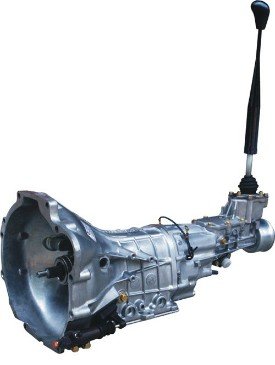
In normal everyday driving shifting gear is a simple and normally effortless experience. Clutch in, move gear selector knob and release the clutch peddle.In basic terms the engine spins the flywheel, clutch assembly and with the clutch peddle released (off the clutch peddle) the engine is connected directly to the input of the gearbox/transmission.
When you change gear and disengage the clutch (foot on the peddle) depending on the selected gear, a synchromesh will match the input and output shafts via the gear ratio selected and a new final drive will be achieved (well if you have a modern car). The clutch peddle is released (foot off the peddle) and the flywheel clutch assembly and clutch gearbox/transmission assembly are directly engaged again and the process is complete.
When the gearbox or transmission is engaged, a pair of gears are working directly together. Both on the input shafts and also the output shafts. Broadly speaking in most gears other than top Gear, a different RPM of the input shaft and output shaft is achieved. The lower the gear the faster the input shaft is relative to the output shaft. In top gear it is normally a 1:1 ratio to maximize top speed and economy.
The output shaft will then transmit the power to the differential which connects these rotations to the driven wheels. Differential ratios are normally 3:1 or 5:1, so there are 3 or 5 revolutions to 1 wheel rotation.
Most Racing Gearboxes/ Transmission have the ability to change the Ratios and adjust the desired acceleration versus overall top speed.
Manual Gearboxes/ Transmissions normally come in two different flavours, Sliding mesh (unsynchronised) and constant mesh (synchronised). But it is normally a combination of the two when you take into account a reverse gear which normally has to be selected when stationary.
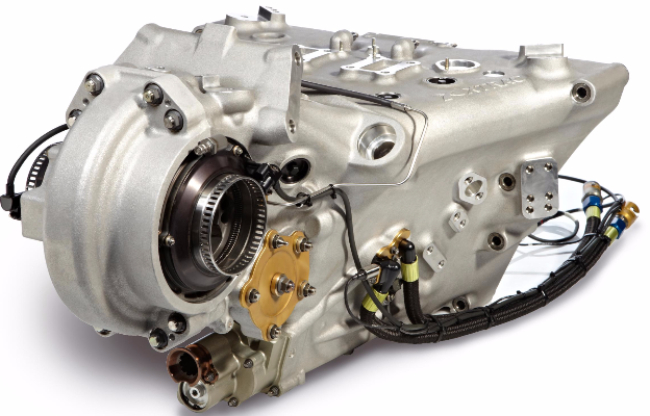
Sliding Mesh: normally used in older car designs or in racing applications, these offer a stronger and simpler design and normally have a shorter shift time, then their constant mesh brothers. Straight cut gear spur sets, spin freely and "Heel and toe" or "Double De clutching" are required to match engine revolutions with the Drivechain and wheel speed.
This is normally on the case on downshifts as you have a slower Gear ratio going up the Gears. Also Gear Clash or a noisy crunch is heard when you get it wrong and try to force the Gear in, causing damage.
Constant Mesh: a relatively new design and used pretty much in most new car designs, it uses Diagonal cut helical ( sometimes double) and are constantly meshed together. A dog clutch is used for changing Gear ( think of a microwave oven plate, connected to the rotating motor).
On these types of designs, friction cones (synchro rings) are used in combination of the dog clutch. It is commonly known that manual gearboxes/transmission yield weight savings, are cheaper to manufacture, also have fuel economy savings and generally have better performance then other types.
2. Automatic Gearboxes/Transmission
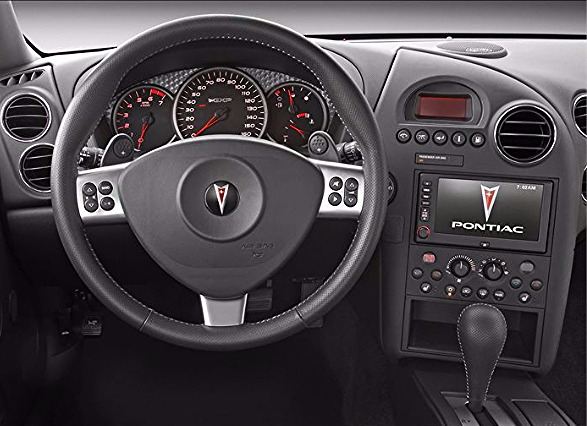
Common is most road cars in the luxury class, also pretty much the norm in the States. This type of Gearbox/ Transmission is simple to use, by selection Drive and with throttle application. The system will pretty much change gear for you with out driver inputs, reverse and manual gear selection is possible.
From a performance point of view, this type of system had a lot of Disadvantages compared to Manuals. Including heavier weight, more complex design with expensive repair bills, poorer fuel economy, less performance in terms of Gear selection times. For the mentioned reason, it's application in Motorsports was limited, but over the last decade the technology has come on with advancements to all these areas.
Some Drivers prefer the feel of the Manual set up, with the ultimate control in their hands. But with the evolution to semi automatic and DSG, the gaps between the two are becoming borderline.
Hydraulics are used to select Gears,with the selection being governed by fluid pressure. Instead of a clutch to control engine power and gear engagement, a fluid flywheel or torque converted is used. A torque converter is a type of modified fluid coupling, consisting of three rotating elements: a pump(driven by the engine), a turbine (drives the drivechain) and the stator (this separates the two and control oil flow from the pump and turbine).
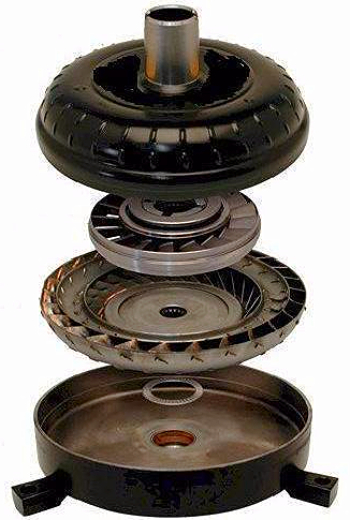
The Fluid flywheel/ Torque converter has three states:
Stall: The engine can be revved hard, but no power is transmitted (as if the clutch is being out or released on a manual) while the brake pedal is held down. This phase lasts slightly longer when the brake is released as the turbine and pump are at different speeds. Torque multiplication can reach there maximum (good for drag racing or in Turbo application).
Acceleration: The load is increasing, but there are still differences in the pump speed and turbine. Torque multiplication are less then in the Stall phase.
Coupling: The turbine has reached 90% of the speed of the pump, this is where torque multiplication has ceased. At this stage a lock up clutch is applied to try and increase fuel efficiency.
A we can see there is a little more than selecting drive and hitting the gas pedal and hopefully this demonstrates the complexity of modern automatic gearbox/ transmission found today.
As mentioned before improvements as been made to try and even out the disadvantages with this system and there are some advantages in Motorsport applications. In some applications these characteristics do have there uses, for example in Drag Racing the Automatic Gearbox/ Transmission can be in the stall phase with high RPM. This is exactly what you need to get a fast launch speed and it is possible to modify the Stall speed to increase the launch capabilities.
In Turbo applications, the ability to have the engine running at higher RMP is especially beneficial to keep the car in the powerband and boost pressure up. Due to the turbo running on exhaust gases, having the constant flow of exiting gas flow keeps turbo lag at bay which normally occurs when the throttle is released.
3. Semi-automatic Gearboxes/Transmission
A semi-automatic transmission (known as clutchless manual transmission, flappy-paddle gearbox, or paddle shift gearbox) is a system which uses electronic sensors, processors and actuators to execute gear shifts on the command of the driver. Removing the need for a clutch pedal wear the driver otherwise needs to depress before making a gear change. As the clutch itself is actuated by electronic equipment which can synchronise the timing and torque required to make gear shifts quicker and smoother. The system was designed by automobile manufacturers to provide a better driving experience, especially in cities where congestion frequently causes stop start traffic jams.
Many modern semi-automatic transmissions can also operate in the same manner as a conventional type of automatic transmission by allowing the transmission's computer to automatically change gear, if the engine reached maximum Revs. Also having the ability to shift gears manually often via paddle shifters.
4. DSG Twin Clutch Gearbox/Transmission
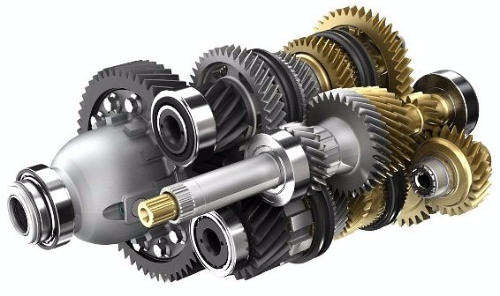
The twin-clutch gearbox/transmission, also known as the Direct Shift Gearbox (DSG) or dual-clutch gearbox/transmission.
It can change gears faster than any other type of geared transmission and is a development of the sequential gearbox/transmission. Twin-clutch gearbox/transmissions delivers more workable power and at a better Rev range than a traditional automatic gearbox/transmission.
Also it is a faster performer than a manual transmission and has been in use in Motorsport for some time. Originally marketed by Volkswagon (VW) as the DSG and Audi as the S-Tronic, twin-clutch gearboxes/transmissions are now being offered by several auto manufactures, including Nissan, Mitsubishi, BMW and Porsche.